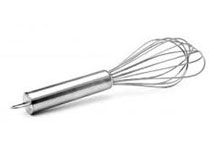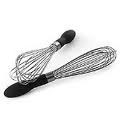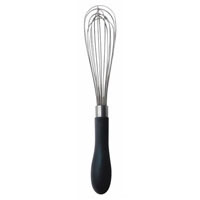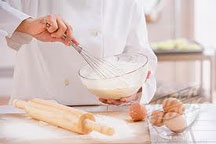Cook'n 101: Whisking and Folding How-To's
By Alice Osborne
 Recipes tell us to do this all the time - whisk this or that until all lumps are removed, all ingredients are nicely combined, and mixture has reached desired consistency. Uh, OK. So HOW do I do this? Come to find out, there's more to whisking than meets the eye, so to speak.
Recipes tell us to do this all the time - whisk this or that until all lumps are removed, all ingredients are nicely combined, and mixture has reached desired consistency. Uh, OK. So HOW do I do this? Come to find out, there's more to whisking than meets the eye, so to speak.
First, using a wire whisk introduces air into what we are mixing and thus creates volume. That's the whole point, really, volume. A fork cannot do this, and sticking two forks together is just lame. The pros all have the same advice on this issue: invest in a nice wire whisk - they're simple but valuable.
Uh, OK. So what do they consider a nice wire whisk? The folks at www.SeriouSeats.com have some strong opinions (but helpful information) on the subject. Here's what I read: "I can't stand it when I reach for a nice big balloon whisk and start beating away only to find out that the wires are too stiff to get decent whipping action and that I might as well be trying to make my meringue with a fork. For me, the ideal whisk needs to combine a few features. Let me break them down.
 "For the most common tasks - making a meringue, whipping cream, emulsifying a vinaigrette—the goal is to take the simple motion of your arm and amplify it to create as much movement as possible inside the whisking bowl. This is accomplished first by having many wire loops. A whisk with a dozen wires is twice as efficient at breaking up liquids, dispersing solids, and incorporating air as a whisk with only six wires.
"For the most common tasks - making a meringue, whipping cream, emulsifying a vinaigrette—the goal is to take the simple motion of your arm and amplify it to create as much movement as possible inside the whisking bowl. This is accomplished first by having many wire loops. A whisk with a dozen wires is twice as efficient at breaking up liquids, dispersing solids, and incorporating air as a whisk with only six wires.
"Similarly, maximizing the movement of each individual wire is a goal. A whisk that's too stiff won't have much more movement in the wire beyond what you give it yourself. Flexible wires, on the other hand, build up potential like a spring when pressed against the side of the bowl while whisking. That potential gets released and the wires flip out, going many times faster than your hand could get them to move on their own.
 "With a good whisk, each of the wires should be a different size (so rather than meeting in a point at the end of the balloon, the wires should remain separate). Their size needs to be different enough that their movement is not constricted by running into each other.
"With a good whisk, each of the wires should be a different size (so rather than meeting in a point at the end of the balloon, the wires should remain separate). Their size needs to be different enough that their movement is not constricted by running into each other.
"Then again, the wires need to be closely spaced and at least stiff enough that you can use your whisk to double as a masher. I use mine to make guacamole in the bowl, or to break up cooked potatoes in my soup to thicken the broth when I want a more rustic texture than a blender will give me. When baking, there's nothing better than the end of the whisk to break up clumps of brown sugar as you try to incorporate it with your other dry ingredients.
"Is it a lot to ask for in a whisk? How about I add that it must be light enough that I can whip my egg whites for five minutes without my arm tiring out? And on top of that, I'd also like a comfortable handle that is grippy enough that I don't drop the whisk when my hand is a little wet or slick with olive oil when making large batches of vinaigrette.
 "So does any whisk in the real world live up to these expectations? Only one that I know of. It's the Stainless Steel Whisk from OXO Good Grips ($8.95). Light, whippy, and grippy, with a full 20 wires, it comes in a 9-inch size great for easy tasks like a few eggs for an omelet or a couple servings of whipped cream, and an 11-inch, larger-diameter size for heavy-duty whipping, like when you finally decide to throw that soufflé party you've always dreamed of."
"So does any whisk in the real world live up to these expectations? Only one that I know of. It's the Stainless Steel Whisk from OXO Good Grips ($8.95). Light, whippy, and grippy, with a full 20 wires, it comes in a 9-inch size great for easy tasks like a few eggs for an omelet or a couple servings of whipped cream, and an 11-inch, larger-diameter size for heavy-duty whipping, like when you finally decide to throw that soufflé party you've always dreamed of."
One common theme I found threaded through most of the chefs' chit-chat on whisks was "When it comes to whisks, take no risks!"
Next, actually using this tool properly isn't that hard, but does take some practice. A few tips I found off of www.SeriouSeats.com, (to help us be more productive whiskers) are:
 Use the right-sized bowl. Most of the time, this means bigger than you think. The bigger the bowl, the more room to move, and the faster your food will whip up. Try it: whip a half cup of heavy cream to stiff peaks in a small bowl, then try the same thing in a large bowl, and see how much faster it aerates
Use the right-sized bowl. Most of the time, this means bigger than you think. The bigger the bowl, the more room to move, and the faster your food will whip up. Try it: whip a half cup of heavy cream to stiff peaks in a small bowl, then try the same thing in a large bowl, and see how much faster it aerates
 Get a grip. For small tasks (things that only require a minute or two of whisking), hold the whisk like you'd hold a pencil, using your wrist to whip it around. For larger, longer tasks, hold the whisk like the handle bar of a bike, using both your wrist and your arm to maximize movement
Get a grip. For small tasks (things that only require a minute or two of whisking), hold the whisk like you'd hold a pencil, using your wrist to whip it around. For larger, longer tasks, hold the whisk like the handle bar of a bike, using both your wrist and your arm to maximize movement
 Double fist it. Don't leave your bowl sitting on the counter or even just sitting still in your hand. Shake and move the bowl the entire time you're whisking - you'll double the motion you get inside, cutting your whisking time by half
Double fist it. Don't leave your bowl sitting on the counter or even just sitting still in your hand. Shake and move the bowl the entire time you're whisking - you'll double the motion you get inside, cutting your whisking time by half
 When whisking eggs, poke then whisk. Use the tip of the whisk to poke the egg yolks until they pop, then whisk away. It'll all come together much faster in the end.
When whisking eggs, poke then whisk. Use the tip of the whisk to poke the egg yolks until they pop, then whisk away. It'll all come together much faster in the end.
Now that we have the whisking details down, how about the folding technique? Folding one ingredient into the next is a delicate process. In terms of delivering information to someone, "folding" could be thought of as "breaking the news gently," while mixing would be closer to "blurting it out."
 So to "break the news gently," we fold lighter ingredients into denser ones, digging deeply into the dense element and delicately lifting it over the lighter one with a rubber spatula. Folding should be done in increments - two or three, at least—and the mixing bowl (make that: folding bowl!) should be rotated often. A little folding goes a long way. We don't want to overdo it; when the ingredients are combined, we're done.
So to "break the news gently," we fold lighter ingredients into denser ones, digging deeply into the dense element and delicately lifting it over the lighter one with a rubber spatula. Folding should be done in increments - two or three, at least—and the mixing bowl (make that: folding bowl!) should be rotated often. A little folding goes a long way. We don't want to overdo it; when the ingredients are combined, we're done.
So while a rose-is-a-rose-is-a-rose, mixing isn't whisking and neither one are folding. And it's to our advantage to know and master the differences!

